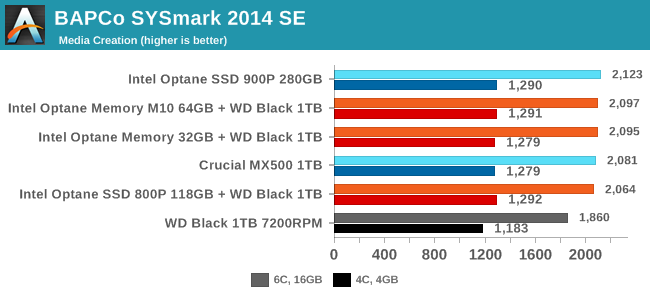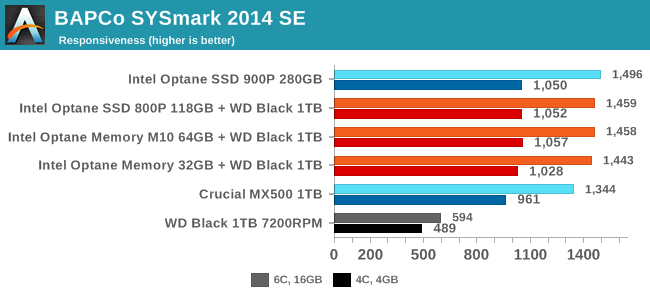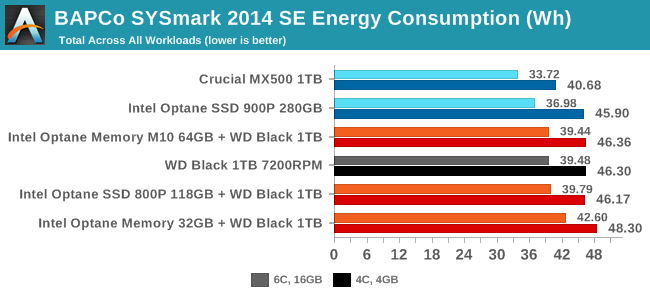The Intel Optane Memory M10 (64GB) Review: Optane Caching Refreshed
by Billy Tallis on May 15, 2018 10:45 AM EST- Posted in
- SSDs
- Storage
- Intel
- PCIe SSD
- SSD Caching
- M.2
- NVMe
- Optane
- Optane Memory
BAPCo SYSmark 2014 SE
BAPCo's SYSmark 2014 SE is an application-based benchmark that uses real-world applications to replay usage patterns of business users in the areas of office productivity, media creation and data/financial analysis. In addition, it also addresses the responsiveness aspect which deals with user experience as related to application and file launches, multi-tasking etc. Scores are calibrated against a reference system that is defined to score 1000 in each of the scenarios. A score of, say, 2000, would imply that the system under test is twice as fast as the reference system.
SYSmark scores are based on total application response time as seen by the user, including not only storage latency but time spent by the processor. This means there's a limit to how much a storage improvement could possibly increase scores, because the SSD is only in use for a small fraction of the total test duration. This is a significant difference from our ATSB tests where only the storage portion of the workload is replicated and disk idle times are cut short to a maximum of 25ms.
For this review, SYSmark has been used on two different machines: a relatively high-end system with a six-core Intel Core i7-8700K processor and 16GB of RAM, and a more limited system with a quad-core Intel Core i5-7400 processor and just 4GB of RAM. The low-end system spends a lot of time swapping thanks to its small amount of RAM, and this adds greatly to the storage workload.
| AnandTech SYSmark SSD Testbed | |
| CPU | Intel Core i7-8700K |
| Motherboard | Gigabyte Aorus H370 Gaming 3 WiFi |
| Chipset | Intel H370 |
| Memory | 2x 8GB Kingston DDR4-2666 |
| Case | In Win C583 |
| Power Supply | Cooler Master G550M |
| OS | Windows 10 64-bit, version 1709 |
| AnandTech SYSmark SSD Low-End Testbed | |
| CPU | Intel Core i5-7400 |
| Motherboard | ASUS PRIME Z270-A |
| Chipset | Intel Z270 |
| Memory | 1x 4GB Corsair DDR4-2666 |
| Case | In Win C583 |
| Power Supply | Cooler Master G550M |
| OS | Windows 10 64-bit, version 1709 |
None of the Optane Memory modules are large enough to serve as a Windows boot drive alone as well as storing all the applications used for SYSmark, so this section only tests the Optane Memory and Optane SSD 800P as cache drives. (The 118GB Optane SSD 800P is pretty much the smallest drive that can could run SYSmark, but it doesn't leave much room for user data.)



The Data/Financial Analysis, Media Creation, and Office Productivity sub-tests are all relatively insensitive to storage performance, and they are shown in order of decreasing sensitivity to the CPU and RAM differences between the two test systems. These results show that a mechanical hard drive can hold back application performance, but almost any solid state storage system—including Optane Memory caching—is sufficient to shift the bottlenecks over to compute and memory.

The Responsiveness test is less focused on overall computational throughput and more on those annoying delays that make a computer feel slow: application launching, opening and saving files, and a variety of multitasking scenarios. Here, moving off a mechanical hard drive is by far the best upgrade that can be made to improve system performance. Going beyond a mainstream SATA SSD provides diminishing returns, but there is a measurable difference between the SATA SSD and the fastest Optane SSD.
Energy Usage
The SYSmark energy usage scores measure total system power consumption, excluding the display. Our SYSmark test system idles at around 26 W and peaks at over 60 W measured at the wall during the benchmark run. SATA SSDs seldom exceed 5 W and idle at a fraction of a watt, and the SSDs spend most of the test idle. This means the energy usage scores will inevitably be very close. A typical notebook system will tend to be better optimized for power efficiency than this desktop system, so the SSD would account for a much larger portion of the total and the score difference between SSDs would be more noticeable.

The Intel Optane SSD 900P is quite power-hungry by SSD standards, but running a hard drive is even worse. The Optane Memory M10 and 118GB 800P further add to power consumption when used as cache devices, but they speed up the test enough that total energy usage is not significantly affected. The 32GB Optane Memory doesn't offer as much of a performance boost, and it lacks the power management capabilities of the more recent Optane M.2 drives.










96 Comments
View All Comments
philehidiot - Tuesday, May 15, 2018 - link
"Fud" is also an excellent Scottish swear word. I particularly enjoy using it due to it's brutal bluntness.ianmills - Tuesday, May 15, 2018 - link
Intel was the one who claimed a coffee lake motherboard was needed for optane. Most likely the slow speed has to do with the spectre/meltdown fix that greatly slows down disk operations done in different user spaces on Intel chipsbananaforscale - Tuesday, May 15, 2018 - link
Oh but it *is* proprietary, you just don't know what the word means. Look it up. It *doesn*t* imply anything about compatibility.nevcairiel - Wednesday, May 16, 2018 - link
All hardware really is, so the only argument anyone could reasonably make would be about the interface/compatibility when using that word.evernessince - Wednesday, May 16, 2018 - link
No reason to buy with an AMD motherboard though, as AMD is handing out StoreMI for free with X470 boards. StoreMI is superior as well.Klimax - Friday, May 18, 2018 - link
Interesting lack of evidence...Dr. Swag - Tuesday, May 15, 2018 - link
Still don't see why a user should choose a 64gb optane drive over, say, a 500gb mx500, which you could use 64gb for caching using RST. The performance difference between optane and an mx500 won't be noticeable when doing normal stuff like booting up and launch apps.WithoutWeakness - Tuesday, May 15, 2018 - link
There are a lot of folks who use their computers for more than just running Chrome and a few games. Many people with professional workflows have storage drives in the 4-8+ TB range but only need to work with ~50-100GB of data at a time. In these scenarios the active data will be automatically cached on the Optane drive and their workflows can be greatly accelerated without the need to copy it to a separate SSD scratch drive before working on it. If you have so little data that you can just run off of a 500GB SATA SSD then obviously just buy the MX500.iwod - Tuesday, May 15, 2018 - link
Surely the same can be done for SSD Boot Drive, this is more of a software advantage then a hardware advantage.CheapSushi - Wednesday, May 16, 2018 - link
You can use Optane drives like any SSD though. Even if these are being marketed as a caching only thing, you can still use it however you like. Want to pay less to try out software caching? Get the cheaper one then and try it out.